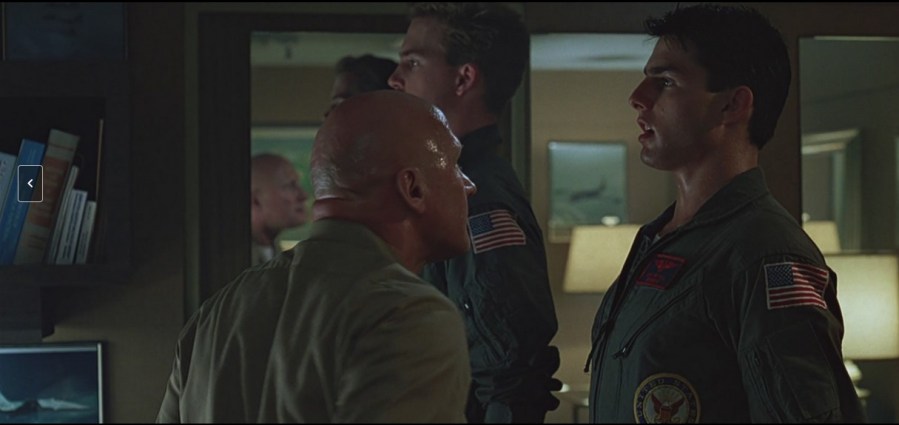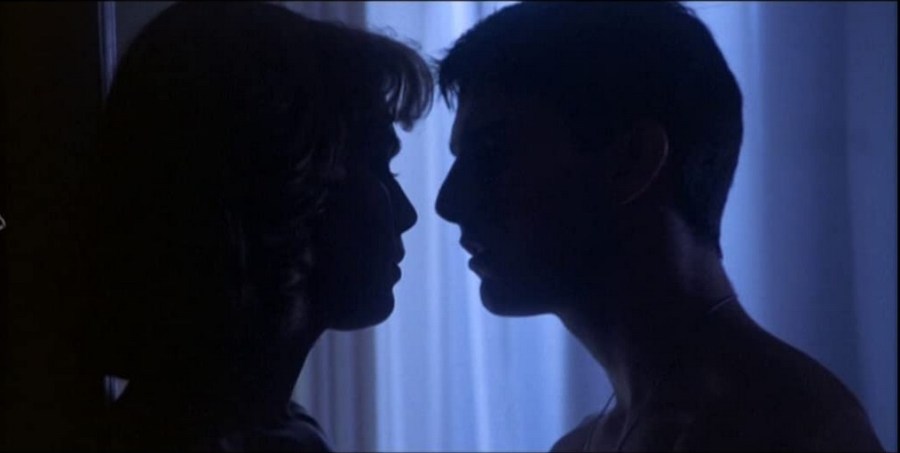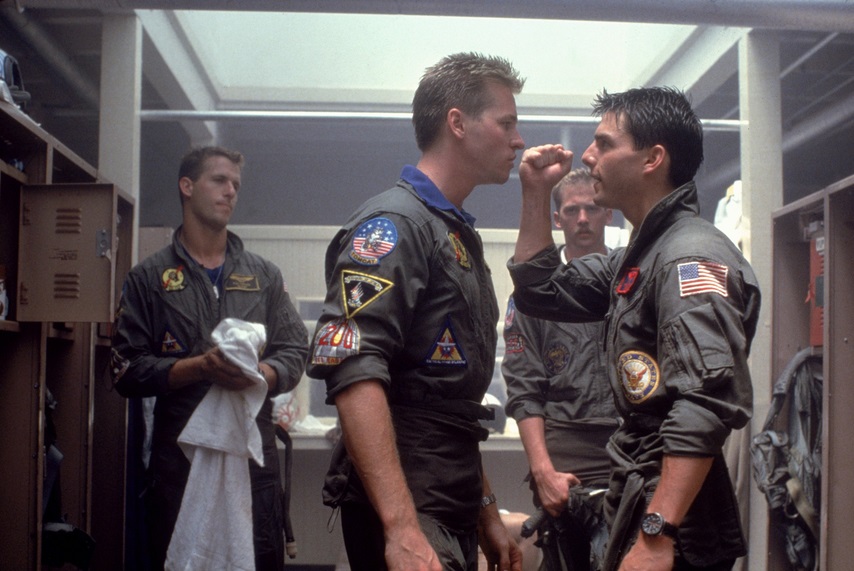Hey: there are red flags in even the best relationships. I should have understood that right away when I started dating my wife all those years ago. Now, I let it slide when she said The French Connection and Bullitt were “boring.” And I said, “Fine, whatever,” when she wouldn’t let me hang up my Shaft’s Big Score! 40″x 60″ poster over our bed. But I should have drawn the line when she confessed that her favorite movie star was Tom Cruise. Yes…she admitted that. Frankly, how is anyone supposed to respond to such a statement? Good thing she looks like a cross between Lynda Carter and Deborah Shelton, and that she hustles out to the kitchen and makes with the pots and pans on a regular basis….
By Paul Mavis
I just saw our Tommy boy is back in the news (nope, he hasn’t assumed the mantle of Xenu 2: Electric Boogaloo yet), flying high with the upcoming sequel, Top Gun: Maverick. So, I thought I’d dig around and see what kind of damage I did to that flick years ago when I reviewed it at another DVD review site that is overloaded with those body thetans. Imagine my shock, then, when I saw I recommended Top Gun, way back when Paramount re-released it under their fun I Love the 80s marketing banner. I must have blocked the whole ordeal.
Click to order Top Gun on 4K UHD & Blu-ray:
Back in the summer of 1986 (when you couldn’t get away from the goddamned thing), I got dragged to Top Gun by a date, after having endured weeks and weeks of its malodorous songs permeating the airwaves, and its laughably bad music videos constantly rotating on MTV. Watching it, I knew it was junk through and through (I made a great case to my date that it was actually a comedy; she didn’t take my calls anymore). However, there was no denying that on the big, big screen, Top Gun did work as a mindless sensory-overload carnival ride, where the roaring dogfight scenes vied with director Tony Scott’s penchant for making every single shot, regardless of its dramatic importance, look like something out of a glossy high-fashion magazine. It was total eye candy, and you forgot most of it on the way back to your car, but it obviously struck a nerve with audiences back in 1986 (it was the biggest grossing movie of 1986, rivaling Chernobyl, “mad cow” disease, and the launching of The Oprah Winfrey Show, for the year’s most egregious newsworthy events).

Today…Top Gun is still twaddle, but there’s no denying it’s competently crafted (and calculated) twaddle, perfectly summing up a time and place in pop culture history that, like it or not, is still influencing how movies are made today. Baby-faced, insanely-grinning Tom Cruise plays Naval aviator Lieutenant Pete Mitchell (lunkhead call sign: “Maverick”), a hotshot pilot who “breaks all the rules” but gets away with it because he’s so damned good at what he does (I need a minute, after typing that…to settle down). After a comical encounter with a MiG-28 over the Indian Ocean, and after fellow fighter pilot Lt. Bill “Cougar” Cortell (John Stockwell) flips out and loses his nerve, Maverick and his RIO (Radar Intercept Officer) Lt. Nick “Goose” Bradshaw (Anthony Edwards) take over Cougar’s intended slot at the Navy’s ultra-elite “Top Gun” school in Miramar, California.

Now it’s time to see if the rebel Maverick, who has serious flying skills but also a serious problem with Navy discipline, can hack it with the top 1% of Naval fighter pilots. Once at “Top Gun,” Maverick immediately runs into trouble on several fronts. He angers his top commanders, Commander Mike “Viper” Metcalf (Tom Skerritt) and Lt. Commander Rick “Jester” Heatherly (Michael Ironside), by being the cockiest S.O.B. they’ve ever seen, perhaps best demonstrated by his juvenile (and dangerous) buzzing of the tower after besting Jester in a simulated dog fight.
RELATED | More 1980s film reviews
He also isn’t getting any respect from probably the best technical pilot in the program, the appropriately nicknamed “Iceman,” Lt. Tom Kazansky (Val Kilmer), who admires Maverick’s skills, but deplores his recklessness.

And further complicating his life, Maverick has fallen for Charlie Blackwood (Kelly McGillis), a knock-out blonde astrophysicist who, although she’s initially only interested in Maverick’s previous encounter with the MiG-28, gradually falls under the spell of his relentless pursuit of her. Now all Maverick has to do is juggle all of these personal and professional problems, while dealing with the ghost of his past (the mysterious—and according to the Navy, the ignominious—death of his aviator father). But none of that will compare to a tragedy that strikes at Maverick’s very core, putting the hotshot pilot into a tailspin from which he may never recover (heehee!).

I remember quite a few miffed critics in 1986 denigrating Top Gun as an ultra-patriotic, jingoistic enterprise in sunshine-up-your-ass “It’s Reagan’s America” flag-waving—a persistent perception of the movie that had even stayed in the back of my mind after all these years. But watching Top Gun today, I was surprised at how indirect (if not outright sublimated) the notion of “patriotism” is in the movie. Hardly a “flag-waver,” Top Gun is certainly pro-military because it treats its characters with respect as to what they do (as indeed it should). That respect for the military, and the movie’s grounded center that acknowledges the military’s essential “correctness” in being an active, training, fighting force (for the sake of protecting our interests at home and abroad) no doubt was a factor in Top Gun‘s box office success. After all, a big section of the American movie audience had tired of over a decade and a half of Hollywood movies and TV shows that painted their military/veteran sons and daughters as louts, murderers and total whack-jobs.

On the contrary, Top Gun‘s central dynamics are remarkably “selfish” (in character motivation), as opposed to being oriented towards getting across a broad blanket of patriotic pride, firing up the audience to chant “U.S.A.! U.S.A.!” in the theater (which, sadly, will probably never happen again). With the “villains” of the piece remaining anonymous (the mysteriously unnamed MiG-28 fighters were North Koreans in the original screenplay), combined with the “peace time” nature of the opening and closing dogfights (the final combat occurs during a rescue mission, with the enemy country denying the fight ever occurred after they lose out to Maverick’s four kills), Top Gun‘s conflict is centered almost exclusively around Maverick’s personal foibles.

With the international conflict safely relegated to the background, Top Gun becomes a Hawksian/Hemingwayesque examination of a man’s struggle to achieve perfection in his craft, while battling with his darker nature to achieve some kind of balance in his romantic life. Of course, this subtext is by no means rendered in a meaningful fashion in the breathtakingly superficial Top Gun; it’s Howard Hawks and Ernest Hemingway as distilled through an eight-year-old’s comic book…which is then adapted for an MTV music video. And that’s a shame, really, because the material is there for a serious meditation on the emotional plight of a Naval aviator, but director Scott and producers Jerry Bruckheimer and Don Simpson (they of the similarly emotionally stunted Flashdance) sell out the story’s potential for pretty pictures and staggeringly facile characterizations and motivations that make Top Gun have the emotional weight of a tsetse fly.

And for anybody even faintly familiar with decades of Hollywood war films, Top Gun is distressingly—even laughably—old-hat. From Maverick’s buzzing of the control tower (they did that in one of the early Abbott and Costello military pictures), to his rivalry with his cold, efficient (but admiring) challenger Iceman, to his breakdown of nerves after losing “Sacrificial Best Friend #1” Goose (who didn’t know Goose’s goose was cooked the minute his Sunday magazine supplement family came scampering into frame?), to his almost turning tail during the final dogfight, only to come back and blast the baddies, Top Gun is relentlessly predictable and thoroughly hackneyed in its story.

Luckily for the moviemakers, none of that pop culture iconography and previously charted territory probably resonated with the young pre-teens and high-schoolers, oblivious to any movie more than five years old, who fueled Top Gun‘s remarkable box office take. Marketed and sold like a gigantic MTV music video, Top Gun hooked the young guys on the macho posturing and the amusement park thrill ride sensations of the dogfights, while the young girls (and, according to the director on this disc’s commentary track, the “San Francisco audience”) openly and safely ogled the hot young male actors who frequently walk around half dressed in the movie (my wife just fainted).

And on that shallow, artificial, one-dimensional level, Top Gun does work well enough. Certainly, the dogfight scenes are the most successful element of the movie. There’s a nicely observed feeling of proportional power to director Scott’s aerial scenes. The opening sequence, showing the F-14s taking off from an aircraft carrier, is rather remarkable in getting across the primitive feel of these powerful jets (in Scott’s foreshortened, telephoto shots, they look like lumbering medieval, fire-spitting dragons), while later dogfights are shot in crystalline blue skies with futuristic hard-edged lines and an emphasis on exploiting the modern wizardry that goes into the aeronautics of these fantastic machines (and no CGI helps, too). For all those audience members who became hooked a few years before on seeing An Officer and a Gentleman‘s Richard Gere’s plaintive desire to “fly jets” (before they got gyped out of actually seeing him do it), Top Gun more than satisfies that need for speed.

Too much of the MTV-obsessed movie-making techniques of the mid-80s, however, can sometimes spoil those fun aerial moments, as well. Choppy editing, that at times renders the individual dogfights incomprehensible in their geography and linear logic, competes with the gawd awful inclusion of thumping, driving song tripe like Kenny Loggin’s Danger Zone (which is repeated to the point of air sickness), both of which contribute to the feeling that Top Gun is an elongated commercial/music video, rather than an actual movie. Into this pre-designed dramatic shorthand are plugged the actors, who have to rely on their charisma alone to make any kind of connection with the audience.
I’ve never been a fan of Cruise, then or now. Katherine Hepburn once said of Meryl Streep that you can hear the tick, tick, tick of the cogs and wheels in her head (meaning Streep’s always calculated and never “real”). Well…Cruise doesn’t even have any cogs or wheels in his head. Some actors radiate an innate intelligence…and then there’s Tom Cruise. But he fits the bill physically here, and his dark good looks contrast nicely with the blonde, statuesque McGillis (even though they seem curiously, um…stiff with each other). Kilmer probably comes off best (look at how he approaches scenes—a real actor—as opposed to “movie star” Cruise), while Edwards is pretty embarrassing in the George Tobias/Alan Hale, Sr. tragic sidekick role (everybody is laughing in this film, but nobody is funny). And the less said about Meg Ryan’s Hee Haw Honeys accent, the better. But again, the actual performances (as with the dialogue and the plot) are secondary to the main purpose of the movie: to overload your senses.

If you’re in the mood to wile away a couple of hours flipping through a heavy, glossy, expensive magazine—but you don’t want to look at million dollar homes, or extensive gardens, or numerous perfume ads—then Top Gun‘s kick-ass, superficial ode to Naval aviators should fit the bill nicely. Unrelentingly dumb and remarkably unmotivated, the visuals still provide some eye candy for zoning out, while every body and every thing looks very pretty and shiny. Too bad they didn’t really try to make a movie, instead of a music video. Still, if you want to understand Hollywood films from the mid-80s, you need to see Top Gun. There are small pleasures to be found there (no, not Tommy). Just don’t tell anyone that you actually liked it.

And just a short note on the extras for this disc (which I normally don’t do because it’s dull and by this point in the writing process I usually need either a nap or the daily scratch sheet). There’s a full-length commentary track featuring director Tony Scott, producer Jerry Bruckheimer, screenwriter Jack Epps, technical advisor Pete Pettigrew, Naval Captain Mike Galpin, and Vice Admiral Mike McCade. Scott and Bruckheimer make sporadic appearances here (the entire commentary has been spliced together from individual sessions), while the Naval personnel take center stage…and they’re terrific. There’s a pretty interesting point, about half way through Top Gun, where Pettigrew, somewhat sheepishly, mentions that someone (probably involved in producing the commentary) has noted that he’s “beating up” on the movie, and that he wants to set the record straight that he actually does enjoy it. It’s an amusing moment, because Pettigrew and the other Naval personnel have almost been laughing at Top Gun up until this point, saying how “Hollywood” it is compared to the real “Top Gun” school (there isn’t even a trophy that guys win at the school—the central plot point of the whole movie is completely invented!).

As well, there are four vintage music videos for the movie: Kenny Loggins’ Danger Zone (jesus, what a nightmare; get off that bed, you idiot!); Berlin’s Take My Breath Away (which is exactly what they can do if I ever hear that goddamn song again); Loverboy’s (hee hee!) Heaven In Your Eyes, and Harold Faltermeyer and Steve Stevens’ instrumental Top Gun Anthem (one of those creepy MTV instrumental videos that had you switching the channel, but quick). Most fun of all are the seven television trailer spots, edited specifically to capture narrow marketing niches: Patriotism, Story, Male Action, Romance, Cruise/Action, Cruise/Moody, and Music. I love to see superficial, soul-deadening Hollywood marketing in action!
Read more of Paul’s film reviews here. Read Paul’s TV reviews at our sister website, Drunk TV.



[…] our Tommy boy supposed to be in another Top Gun fest this summer? What’s that? Not a Top Gun? Another Mission: Impossible? They’re not pumping out TP (yes, it can mean “toilet […]
LikeLike